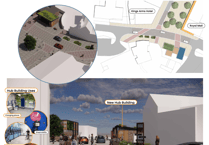AN “AT-RISK” 17th century listed building could be a home once again if a planning application is approved.
Yew Tree Cottage near Grosmont, in north east Monmouthshire, was Grade II-listed in 2005 despite its condition and it is currently on the county council’s register of buildings at risk.
When it listed the empty home, which is within the Three Castles Historic Landscape area, heritage body Cadw said despite its “poor condition” it represented “the significant survival of a house of circa 1600”.
It found the house retained much of the layout plan of homes from that period and some “good original detail”, including two windows, described as rare surviving examples, and original timber including a post-and-panel partitions with ornate doorhead.

The older part of the house is described as a “standard Monmouthshire long house” constructed from “random, old red sandstone rubble” and the building has a ‘T plan’ footprint due to a later early Georgian cross wing built at the front of the house and described as a “polite” elevation.
Mr C Edwards, of Mitchel Troy, is seeking planning permission for alternations and renovations to bring the building back into residential use, as well as listed building consent.
A heritage statement submitted as part of the application describes the “whole building” as having “high significance; however, it is the retention of the long house north section and associated decorative timber components which has exceptionally high value.”
The application states: “The main objective is to return the building to its historic use that of a family dwelling. The dwelling shall be a three bedroom house with downstairs shower room and principal bathroom to the first floor. This modest proposal respects the existing layout of the building.”
It also says the applicant has opted against having one en-suite bathroom in every bedroom as “this would undermine the special character of the internal plan”.
A structural report also prepared as part of the application states: “The main house is in a poor condition and completely derelict.”
Such is the condition of the house the civil engineer couldn’t access the first floor when she visited in early March this year however the house is described as “well built” despite its current state and exposure to the elements.
It isn’t known when the house became “obsolete” but some decorative finishes, that have deteriorated, in the more recent extension are described as appearing to be of “a late 20th century origin”. Its chimneys will also be taken down and rebuilt.
The building was first registered as Yew Tree House and two tracks provided access to Yew Tree Cottage from Hill Farm and the nearest neighbouring property Beech Hill which was occupied by John Powell who was the father of the landowner Thomas Powell.
Only the track from Beech Hill provides access to Yew Tree Cottage today.
It’s hoped renovation work will uncover further evidence of the historic plan of the building with parts lost when the 18th century extension was added.





Comments
This article has no comments yet. Be the first to leave a comment.